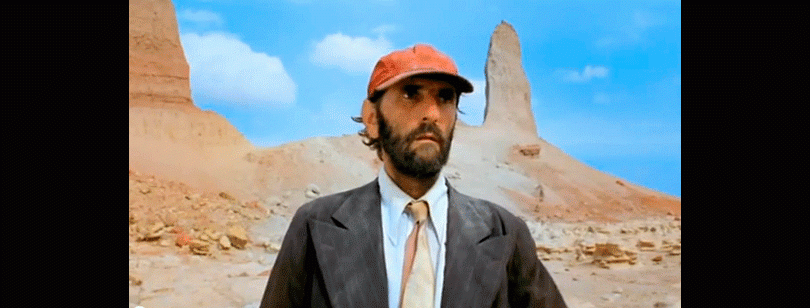
Media in film
The discipline of film studies has long been interested in the reflexive potentials of the film medium. Analysts have spent much time burrowing into the ways films can be about acting in films, about producing them, or experiencing them. Less attention has been given to films that are about other media, and to what such films may tell us about the conditions and experiences of mediation. But just as the medium of film can tell us much about itself, it can also speak to the ensemble of media that film is a part of, to that ensemble's myriad of meanings and experiential qualities.
Paris, Texas (Wim Wenders, F/G/UK/US, 1984) is a film about film to a degree, since a home movie plays an important part in it. But this film is also about many other media of reproduction – about some polaroid photographs, a telephone and a loudspeaker linked to each other, and a cassette recorder that can record and play off a human voice. In this sense
on can say that Paris, Texas displays a media-saturated world, as many contemporary films have done. For a time it was common to term such films "postmodern". Postmodern interpretations of films that deal with media saturation for a time tended to circle around the illusory qualities of such films, the ways they destabilised the relation between reality and mediated simulations of it.[1]
Paris, Texas invites a different kind of reading. Here, media are more like braces, particularly for the film's protagonist Travis. They are what he resorts to, in order to be able to live with a communicative and existential gap inside. One could also say that media are like crutches to him, they help him stand on his legs and to go on. Or one could say they are like sunglasses; when the world becomes too glaring and intense, media can provide a degree of protection that enable him to keep on facing what is out there. The portrayal of a gap inside Travis, and the ways he comes to terms with it by using media, are one main reason why Paris, Texas is such a touching and memorable film.
Nothing, going on
At their very beginning, films will have to transition from a silent, dark screen into image and sound. All films in a certain sense start from nothing. Paris, Texas not only starts from nothing, it goes on in a state of nothingness for quite some time. The opening scene is set in emptiness and desolation. The barren desert landscape is initially shot from an aerial point of view that emphasises just how much there is of this desert and how little there is in it. The location is Big Bend, a characteristic mixture of mountain shapes and desert in the Southwest part of Texas, close to the Mexican border. Big Bend is a particularly barren and inaccessible area, even by the standards of this vast, dry state.
For those familiar with western movies, the opening sequence of Paris, Texas shows off a familiar, even iconic, landscape. The classical westerns featured male protagonists who conquered the Wild West with their guns and horses. For those who have spent some time watching the genre, then, the sight of a lone man wandering through the desert at the start of the film may be familiar, even reassuring. Paris, Texas invites such expectations – only to frustrate them very quickly. When the protagonist Travis appears, he seems lost. He moves mechanically, wears an incongruous dirty suit and tie, and is about to run out of water in the heat. Travis' facial expression is hard to interpret. There is a hint of uncertainty when he empties his water can, of melancholy and vulnerability when he eyes the reddish barrenness before moving on.

The actor Harry Dean Stanton has a remarkable knack for suggesting emotions that may or may not be there. His face seems alive with the promise of feeling, drawing our attention – but also seems to close off before we can satisfy ourselves as to what is going on inside him.
Then Travis presses on mechanically through the desert with the long, stiff strides of someone who has long stopped caring about how he may look to others. Where is he going? The question stays with the viewer for most of the film. When other people come into the picture, they have a hard time making this out, and it proves hard for Travis to make out as well. He exists in a state of nothingness that exceeds the desert geography of Big Bend and makes us worry for him. The greatest and final nothingness, after all, is death.
A communicative gap
Travis walks through Big Bend until he comes to a cluster of houses, exhausted. There he is discovered and taken care of. The locals call up Travis' brother in Los Angeles, attempting to find someone to take responsibility for this strange man. It turns out Travis does not speak; he does not answer and stares past people when they try to address him. Travis seems to be turning perpetually inwards, away from communicative contact with others. He does react to things that happen on occasion, he seems to think and feel somehow. Still his life seems to be mostly an inner one. A gap exists between him and the world, in several senses of the word. Travis exists in a geographic gap, in a barren emptiness between human habitations. Later we learn that he has been gone for four years, a temporal gap where no one knew where he was, a period that seems struck from his own memory as well. Travis' mute inwardness speaks to a communicative gap that is also an existential gap.[2]This gap separates him from contact with other people, but also from contact with his inner self.
Travis will start to talk, eventually also about that gap inside, but here at the beginning of the film he is mute. Instead it is Ry Cooder's famed soundtrack that speaks of the solitude of the soul. This blues-derived music is as ripe with Americana as the Wild West landscape – and at the same time it strikingly conveys the sense of emptiness and desolation. While the screen is still black, faint atmospheric sounds are heard that conjure a landscape even before the images do. One can make out faraway bells from churches. Other parts of this soundscape lack recognisable contours but may remind one of the creaky sounds of old doors being opened slowly. It is tempting to say that these are secret sounds; they seem somehow to suggest a world of the past and of the imagination.
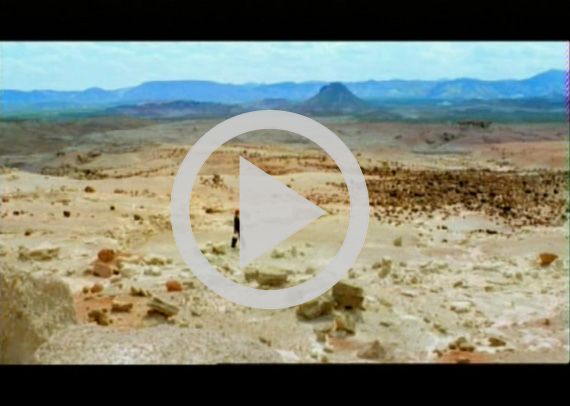
Clip: Paris, Texas (Wim Wenders, 1984. Road Movies Filmproduktion).
This soundtrack articulates the feeling of emptiness in the film, in a somewhat paradoxical way. Some sounds can do this: the call of an owl conjures up the silence of northern landscapes; the chirping of crickets does the same in southern ones. In a somewhat similar way one might say that Ry Cooder's soundscape contains the sounds of humans that are gone or belong to the past, a past that has turned words to whispers and reverberations of bells in churches no longer standing.
The soundtrack probably rises to the forefront of most viewers' attention at the point where the well-known slide guitar theme arrives, together with the film's title graphics. Cooder plays a version of Blind Willie Johnson's classic blues tune from 1927, Dark was the night, cold was the ground. This version is slowed down, suspended and hanging in the air as the rhythmic and partly the melodic progression of the tune is removed. There is a great sense of desolation to this music, particularly in its combination with the imagers of Big Bend, and a great beauty. Those who know the title of Blind Willie Johnson's original version may also be reminded of the blues tradition's preoccupation with all that is too late and all that is in vain.
The photographs
In the beginning of the film, Travis is so closed off from communicative contact that he does not even talk to his brother when the latter comes to Texas for him. The film viewer is made to wonder what it is that has closed him off so radically from others. Pretty quickly we are given hints to suggest that he is in denial of something traumatic. In the four years when no one has heard from him, Travis has been on a kind of run, probably over the border to Mexico. He has had a family, a wife and an infant son, but has been separated from them in circumstances unspecified but traumatic. Travis' brother Walt and his wife Anne have raised the son in the absence not just of Travis but also his wife Jane. Like Travis, Jane has disappeared too.
Pretty soon it is possible for the film viewer to make out that Travis carries a heavy burden of guilt, maybe also anger. As we realise this, we may come to project a filmic future about reconciliation and about Travis reconnecting with the people in his life. There is indeed a main narrative in Paris, Texasthat leads from the desolate nothingness of the opening sequence, forward in time to when Travis is reconciled with his son Hunter, and forward further to when Travis is able to reunite Hunter with his mother Jane. Another narrative thread, more fragmented and implicit, leads back in time. It suggests that Travis and Jane were once a loving couple but that their relationship gradually deteriorated, at least in part because Travis was jealous and controlling, until it broke down dramatically and finally. We also learn that Travis at one point bought a plot of land in Paris, Texas – the place where Travis was conceived, according to his father.
The information about events in the past is conveyed in spoken hints, and via photographs. Particularly important are two polaroid photos in a strip that Travis has carried around in Big Bend. He has left everything behind – except these images.
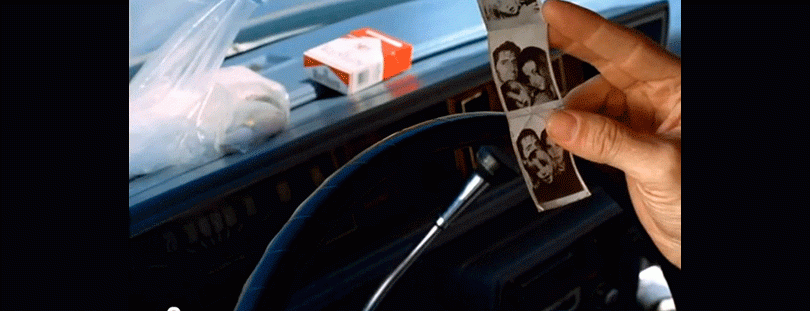
This strip of polaroids, presumably from a photo box, came from inside the small bag seen above left in the still image. That small bag contained all of Travis' belongings at the time when Walt found him. He fled from his family – but as these photos show, he also carried them with him. There is such a contrast between these small black-and-white images and the desolate landscape they have ended up in. They are as ripe with togetherness as Travis' life in Big Bend has dried up in loneliness.
Who has not at some point crowded themselves into a photo box with family or friends in order to snap pictures of this type, experiencing that happy noisy togetherness feeling of thronging together? The act of carrying around such images that many of us have as a habit, is a modern parallel to using talismans. Even if we know the difference between a visual representation and that to which the representation refers, it still feels a little bit as if the actual person is with us when we carry such pocket images around, and the thought is a comforting and pleasurable one. When we learn about Travis' past and the way he has severed his relationship with it, we may also see those polaroids as small, imaginary bridges to that past, stowed-away traces of hope in the wilderness. But at the same time there is something distant about these images, grainy and somewhat blurred as they are, as if they had caught distant memories on photographic paper.
The image of nothing
Another important photograph in the film is shown by Travis to his brother Walt, in the car as they drive from Texas toward Los Angeles where Walt lives. At one point, Travis has suddenly started to talk. His first abrupt word, sitting in the back seat, is "Paris". He wants to go to Paris. Walt, already frustrated by his brother's prolonged and obstinate muteness, looks like he is afraid that Travis really has a screw loose. It turns out that Travis is referring to a place called Paris in Texas. He shows Walt a photo of this place.
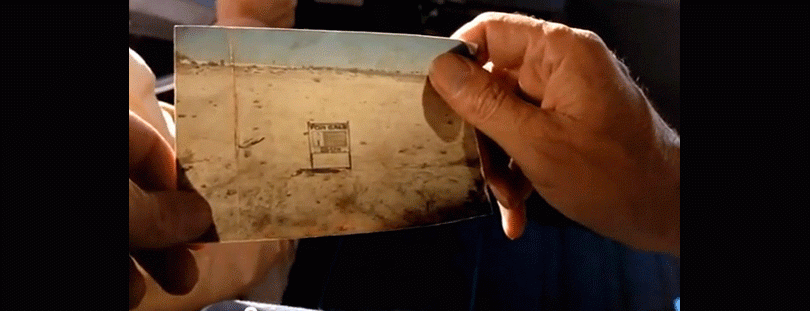
As it turns out, Travis has bought a plot of land in Paris, Texas, and is carrying this photo around as evidence and perhaps reminder. The image is clearly important to him, much as the polaroids are. But this is a paradoxical image, since it is completely empty, a visual nonentity. The presence of a "for sale" sign planted on the flat, yellowish plain if anything strengthens the sense of emptiness. Nothing has been for sale, and then Travis has bought nothing. If this is Travis' dream, then the film seems to suggest strongly that the dream is an impossibility.
The absurdity of an ideal point of origin and destination that is an absolute nothing seems to strike Travis. It really is a frightening thought, an abyss to stare down into, but the sign that dutifully informs that nothing is for sale also has a certain comical potential. Travis seems to choose the comedy, perhaps from a need for self-preservation. Here is the dialogue (written by Sam Shepard) that ends the sequence in the car:
Walt (examining the photo): There’s nothing on it.
Travis (giggling to himself): Empty.
Walt: Well why would you want to buy a vacant lot in Paris, Texas, for Christ’s sake?
Travis (suddenly anxious): Uh … I forgot.
Paris, Texas is a film about journeys of both the body and the mind, but no one arrives at this travel destination, the vacant lot. Travis' journey from communicative denial to reconnection is never completed either, even if he will move significantly out of that desolate place he is in at the beginning of the film. It may be more accurate to say that Travis learns to cope with his inner desolation. In the film, reunions jostle with separations for the upper hand. Travis goes with his brother to Los Angeles and reunites with his son Hunter – but then the two go off to find Hunter's mother Jane, leaving the two who raised Hunter heartbroken, without explanation. Hunter and Travis travel back to Texas, to the big-city world of Houston in search of Jane. Hunter is reunited with Jane – but Travis is not. On the contrary, he leaves them both, again without a clear explanation.
At the end, then, this becomes a film about broken relations as much as mended ones. Travis never finally arrives in the world of human togetherness and affirmation. What he does find his way to is himself, and this helps his relationship with others, if mournfully and indirectly.
The home movie
One evening, four people decide to see a super-8 home movie recorded a long time ago. All of them except Travis have seen it many times before, and all of them recognise what happens in the movie. After all they are in it, they recorded beach resort scenes the way people on holiday do. These are your typical summer holiday images: Two couples are travelling together, Travis and Jane are going with Walt and Anne, we see them in the car, then on the beach. The four are fooling around, the couples flirting. The small boy – Hunter at two or three years of age – gets to sit on his father's lap and steer the car. Except for a scene where Travis' and Jane's playfighting seems for a second to spill over in real conflict, the mood is sunny.
Those of us who grew up with super-8 home movies will be able to recognise from deep within our sensory memories the experience of super-8 images. Their colours are somewhat faded but warm, the contours are fuzzy, small dark flecks and stripes dart across the screen. And the sound of the projector is unmistakable, a whirring of the film rushing through the mechanics. When we look at Travis, Hunter, Walt and Anne looking at the home movie, and sometimes at each other, all we hear is the whirring of the projector. When the film spectatorsees the same as those four – when the home movie fills the cinema screen – we hear Ry Cooder play a Mexican tune, with the projector sound mixed low in the background. The super-8 film itself does not seem to have sound. The act of placing Cooder's soft, tuneful and slightly melancholy playing where the sound of voices and cars and the ocean could have been strengthens the sense of this home movie being a memory of feelings past.
When a cut intermittently returns us from the home movie to the four people silently watching, the music disappears and the room is filled with the whirring of the projector. It is as if this memory-sound, and this recalling of sunnier times long ago, envelopes them and holds them tight. And it visibly does them good, Travis included. It is as if these images and sounds of the past ease the access to memories that were difficult for all of them and impossible to live with for Travis.
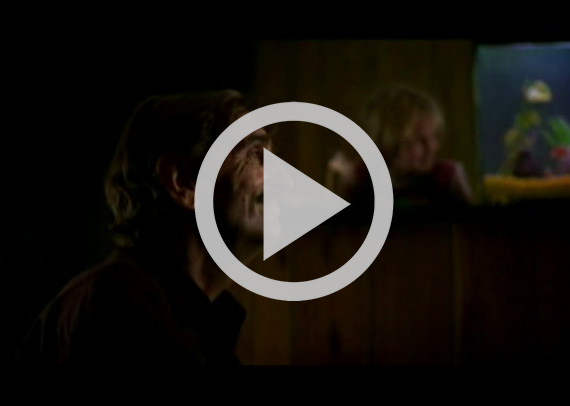
Clip: Paris, Texas (Wim Wenders, 1984. Road Movies Filmproduktion).
Images of one's own past seem often to hover somewhere between recognition and alienation. They provide the potential to experience one's previous self as a stranger, but also to reconnect with who we once were. The only words said during the whole of this sequence of Paris, Texas are said between Travis and Hunter while they watch Hunter on his father's lap, trying the wheel of the car. ”That’s me”, says Hunter. ”Yeah, you’re gonna be good”, says Travis. They share a small smile. It's not that much of a dialogue on the face of it, a mere exchange of mundane pleasantries. Its deeper significance is to draw the image and its past into the together-world of father and son. That little exchange extends their mutual world not only back in time but also forward, into a future of hope and togetherness. We may think the mundane and the profound are opposites, but sometimes, as here, they meet When the home movie ends and the screen suddenly goes blank, there they are together, surprised by this blessing.
That togetherness is an awful lot, but it is also all, at least for Travis. The sight of this home movie seems to be a decisive moment for him in many ways, maybe also a key moment of disillusion. The one person onscreen he cannot watch is his wife, Jane. When she is on camera, he looks away. When she is in a close-up, he closes his eyes. When that just a bit too discordant bit of playfighting comes, he hides his face in his hands and rocks from side to side. Travis seems to need not just the access to others that media provide but also their element of distance – and when they cannot calibrate sufficiently he must try and do so himself. Closer, via the images, but not too close.
The impossible meeting
The dramatic climax of Paris, Texas consists of two sequences where Travis finally encounters Jane. They remain separated, however, in different rooms. She is working in a sort of peepshow, where men pay to enter a dark room in order to watch women through a one-way mirror while talking to them via telephone. So Jane has ended up in a pretty demeaning line of business. Demeaning too is the way Travis has to sneak into the peepshow; he has to take the position of the peeping tom vis-à-vis his own former partner. A peepshow with a one-way mirror is hardly the ideal place for a loving reunion. The whole setup is about a rather unequal and problematic kind of one-sided communication. One wonders how in the world the two will handle these circumstances.
It turns out to be very hard. The first of the two encounters is dominated by communicative troubles, while the second provides some sort of resolution – or at least a means of living with the problems, again with the aid of media. In the first meeting, Travis quickly loses control. First he is unable to talk, as mute as he was in Big Bend. He cannot even watch her, made up in sexy attire on the other side of the mirror. Jane, meanwhile, is clearly a routine hand at the kind of chattiness the situation requires of her and does not realise who is there. When Travis starts talking, the situation rapidly deteriorates into a jealous interrogation of Jane – how much money she makes, what else she is doing, if she meets up with her customers, if she goes home with them. This is the Travis who first Jane fled from and then Travis himself. The whole situation breaks down, she wants to go, he begs her to stay and makes desperate excuses. Then he can take no more and leaves.
There is something unreal about these sequences in the peepshow. Some of the reason may be that they are in fact pretty unrealistic. Peepshows are unlikely to be used much for relationship repair. It is also somewhat peculiar that Jane will recognise Travis only toward the end of their second meeting. Although the realism is lacking, one might say in the film's defense that these sequences deal with something that is in itself unrealistic: the final reunion of Travis and Jane. What we get instead is the expression of a longing for this reunion, of its impossibility, and of how the two deal with that impossibility.
The telephone and the loudspeaker
In the second meeting of the two, Travis returns with a communicative solution that is true to character: he wants to open up by closing off. Travis closes off by turning away, he positions his chair so that it points him away from Jane. Then he opens off by talking to her on the phone, this time without anger or accusations, while he stares off into the darkness of the room's back wall.

Looking at her, Travis got too close and out of hand, so he tries only using his voice and hearing in order to balance out closeness and distance, communicative contact and isolation. Travis also in a sense closes off by only talking to Jane, not with her. He replaces dialogue with monologue – but not in order to one-sidedly dominate the other part, which is often the view we have of one-way communication. There are strong potentials in many types of one-way communication for this kind of dominance, as evidenced historically in the propaganda of mass rallies and mass media. But one-way communication also has a fundamentally uncertain side to it. A gap between sender and receiver is always there, in the sense that we can never be quite certain how the other party will make sense of what it is we are trying to say. That is why, considering this gap, Jacques Derrida has claimed that the communicative movement from a sender to a receiver is a process of "dissemination".[3]
The media in some respects widen this gap, since mediated communication mostly happens between parties that are not physically co-present. But they can also be used to build bridges over the gap. The media technology of the telephone is used by Travis to build a bridge that at least he can muster the courage to take a few steps on to. Into the dark and into the telephone, Travis tells the story of a young woman and an older man who got together and fell head over heels in love. He tells of how much they loved each other and how mutually fixated they became, how he neglected his work and his friends to be with her, how that started to worry her, how he reacted by losing his grip, becoming jealous, turning to drink, controlling and harassing her, until she tried to flee from him. Then he would hunt her down and tie her up. One night he woke up to find her gone and the house on fire, and then Travis fled. This is how he describes that last night, speaking of himself as from afar, in the third person:
"… he was surprised at himself because he didn’t feel anything anymore. All he wanted to do was sleep. And for the first time he wished he were far away, lost in a deep, vast country where nobody knew him, somewhere without language, or streets. And he dreamed about this place without knowing its name. And when he woke up, he was on fire. There were blue flames burning the sheets of his bed. He ran through the flames, toward the only two people he loved, but they were gone. His arms were burning, and he threw himself outside and rolled on the wet ground. Then he ran. He never looked back on the fire, he just ran. He ran until the sun came up and he couldn’t run any further. When the sun went down he ran again. For five days he ran like this, until any sign of man had disappeared. "
The place Travis ran to was the nothingness of Big Bend, the place and the state of the film's opening sequences. Here toward the film's end, that flight into nothingness is described by Travis himself. The mute man has become the protagonist of Travis' own narrative. The narrative is told in past tense and the third person; it tells of Travis as he was, not as he is. As Travis speaks about that final flight, Jane realises who he is.
At that point the communicative tyranny of the one-way peepshow setup becomes unbearable. It occurs to Travis that maybe the one-way mirror can be subverted by turning off the light in Jane's room and turning it on where Travis is. Will they finally be able to see each other? This is the ideal and hope for dialogic communication; sensing each other fully in the moment we come into real contact and are able to open up to each other. But communicative dialogue can be understood in many ways. It can also be conceived of as two people taking turns at listening and monologuing. And while we do our monologue we never quite know how it will be received. Thus we are alone with ourselves while talking. We direct ourselves to the other, we address the other – but unavoidably we are also at the same time addressing ourselves.
At one point, Jane comes in close to the mirror, trying to catch a look at Travis. Then the reflexes created in the one-way mirror by the reversals in lighting make Travis' face appear inside the contour of Jane's head, so that it looks to the audience like as if a woman's head has grown a man's facial traits. The impossibility of this melting together makes its illusion an eerie, almost frightening thing.
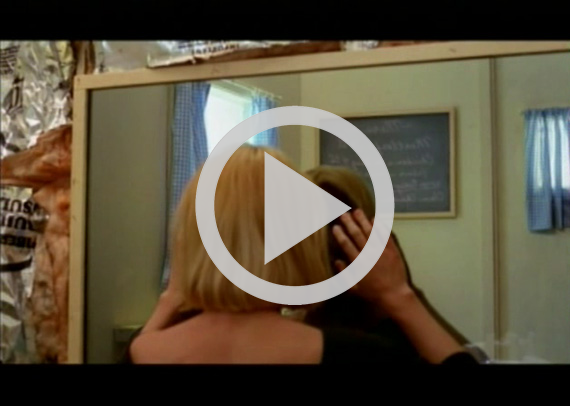
Clip: Paris, Texas (Wim Wenders, 1984. Road Movies Filmproduktion).
The attempt to undermine the one-way working of the mirror is still successful, in the sense that Jane can now actually see Travis. He tells her where to find Hunter, but then wants to leave and now it is her turn to beg him to stay. Then he says, dejectedly, "I can't see you, Jane." They can only take turns seeing each other. The one who speaks will never be able to see the other's face, only his or her own image in the mirror. It is a moment of profound resignation.
Still, as Travis and Jane have spoken in monologue they have also both listened, this time over. Maybe they have even really understood each other, this time over, not just in an unimaginable place but also in a new way. Then Jane takes the loudspeaker in her hands and tells her story to it. She narrates her own ruined life after the final breakup, how the memories of Travis still reverberated in her head for the longest time, how she kept imagining herself talking to him, and him answering.
Finally she came to realise that she was alone for good – but in the composition of the filmic image at the closing of the final meeting sequence they are united. They form one diagonal line that runs through the one-way mirror: him, then his telephone; her, then her loudspeaker. They both stare into nothingness. It is very sad, and very beautiful.
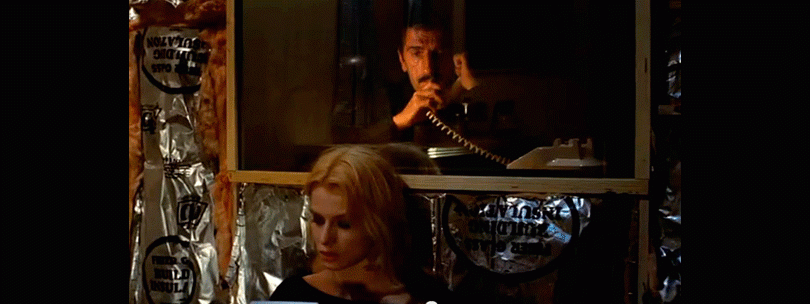
The cassette recorder
Before his last meeting with Jane, Travis makes a recording of himself, speaking a message to Hunter into a portable cassette recorder. The recording is Travis’ farewell message to his son. Moments later he will hand it over to Hunter, saying only that he should listen to it after Travis has gone to meet Jane for the second and last time.
The cassette recording is Travis’ one spoken and direct profession of love for his son in the film. It is also the one time in the film when Travis speaks about his realisation that a reunion with Jane cannot happen. It is also the one time he speaks of a gap inside himself. Now that he is able to speak of his inner emptiness he is also able to talk about feeling love. Here, too, it is via an auditory medium that Travis can express what he is not able to say directly. This is what Travis speaks into the cassette recorder:
"Hunter, it’s me. I was afraid I’d never be able to say the right words to you in person, so I’m trying to do it like this. When I first saw you, this time, at Walt’s, I was hoping for all kinds of things. I was hoping to show you that I was your father. You showed me I was. But the biggest thing I hoped for can’t come true. I know that now. You belong together with your mother. It was me that tore you apart and I owe it to you to bring you back together. But I can’t stay with you. I could never heal up what happened. That’s just the way it is. I can’t even hardly remember what happened. It’s like a gap. It left me alone in a way that I haven’t gotten over, and right now I’m m afraid. I’m afraid of walking away again, I’m afraid of what I might find, but I’m even more afraid of not facing this fear. I love you. Hunter. I love you more than my life. "
Up until this point in the film, Travis has used media, but here he creates something using the medium, and that is a different quality of experience. Listening to an audio recording of oneself carries some of the same strangeness as super-8 films do: that is me, but also someone else – someone who feeds back into our reflections on who we are and should be. Do I talk that abruptly? Do I really sound like that? And then the process of recording provides an opportunity to work on our selves. How do I want to appear on the next take?
Michel Foucault has written on this dynamic between ourselves and mediated representations we make to deal with who we are, our subjectivities, even our souls. Foucault is concerned not with modern auditory media, but media of writing in the classical era, particularly letters. Still there may be some common traits. When we write a letter to someone close to us, we arrange a kind of virtual meeting with that person, says Foucault. We conjure up as present someone who is absent, in such a way that we seem to feel the presence of that person. As we write in this way, writing works back on ourselves. It makes us examine ourselves from the outside, as the intended reader of our letter would do. This encourages self-command and a sense of honesty about ourselves. And by bringing to light the impulses of thought, writing dispels the darkness, Foucault memorably says.[4]
Travis seems to be trying for all of this, as he speaks his message, his spoken letter, to his son into the cassette recorder. He is confronting his own hopes and fears, and he does it with a directness and self-command that demonstrates how far he has come since the empty shell that trudged mechanically through Big Bend. At the same time he seems to be edging toward the darkness of acts he committed, the responsibility and the shame.
But who knows how Hunter will receive Travis’ message? The sender can only humbly hope for the receiver’s understanding. Today’s media tear the message loose from the contexts that help anchor meaning. They uncouple the message from its time, space and from social context, spreading it ever more radically and making its destination ever more uncertain in the process. In one of the last sequences of Paris, Texas, Hunter silently sits holding a cassette player that plays Travis’ message to him. Hunter is in the hotel room where he will soon meet his mother again, for the first time in four years. Media technologies are strewn around him: comics, a phone, a TV. On the other side of the plate glass window is the big city of Houston, itself a media-saturated environment. How Hunter will sort his father out from all the disembodied voices and images coming at him from all those media, no one knows.
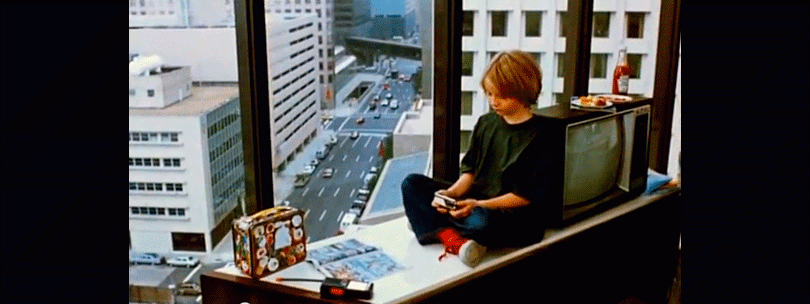
Hunter listening to Travis’ cassette recording in the hotel room. Framegrab: Paris, Texas (Wim Wenders, 1984. Road Movies Filmproduktion).
Sunset
At the end of the film, Jane comes to the hotel room and is reunited with her son there, while Travis stands outside and watches from a distance. Their happiness makes a jarring contrast to his loneliness – but it is, after all, what he wanted and what he made happen.
The very last images in Paris, Texas are of Travis, behind the wheel, leaving Houston. Again this face that is so compelling but so hard to make out. In the course of the film we have seen him open up, at least some of the way, but here he seems somehow closed off again, as he looks away and his features are blurred by red evening light. Travis is on his way back into the darkness, and the gap between him and us opens as before. Maybe John Durham Peters is right to say that "Communication is a trouble we are stuck with"[5]. Still the film may leave us hoping that the darkness does not quite look the same to him now, that he can explore it and not get lost.
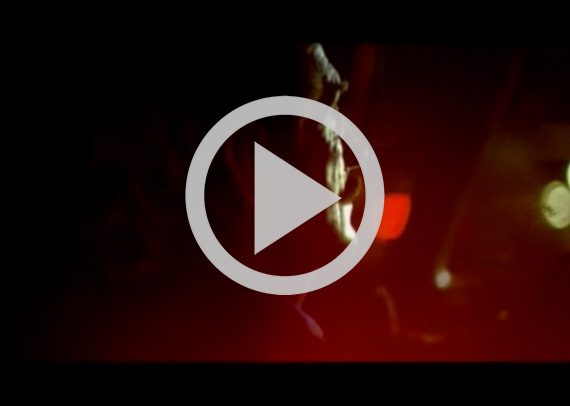
Clip: Paris, Texas (Wim Wenders, 1984. Road Movies Filmproduktion).
There is no location sound accompanying these final images. Instead we hear Ry Cooder’s slide guitar. It is hard to avoid the impression that this music somehow characterises Travis’ state of mind. The musical theme in the film’s opening sequence was a static, meditative version of Blind Willie Johnson’s Dark was the night, cold was the ground. This time over, Cooder plays a more forceful, intense version in a major mode, retaining more of Johnson’s melody. Maybe the difference between Cooder’s guitar here and in the opening sequence relates to a greater sense of clarity and personal purpose.
In the Westerns, heroes rode stereotypically into the sunset, to end the film on a poignant note. Travis undeniably does something similar. He is no hero, however; no antihero either, really. The human relations that protagonists in more traditional genre films establish so nicely with helpers and romantic partners – at least toward the end of the film – elude Travis, perhaps permanently. But the contrast between the familiarity of the Western genre landscape and the lost figure of Travis is not as stark in the final moments of the film as it was in the beginning, after all, and the sunset over America’s great open vistas is still beautiful.
BY: ESPEN YTREBERG / PROFESSOR OF MEDIA STUDIES / DEPT. OF MEDIA AND COMMUNICATION / UNIVERSITY OF OSLO
Notes
[1] Early analyses of Paris, Texas tended to be influenced by postmodern and poststructuralist theories. They raised the issue of mediation via discussions of “simulation” and the “hyperreal”. See e.g. Richard Kearney (1988). The Wake of Imagination: Toward a Postmodern Culture. Minneapolis, University of Minnesota Press. The important role of media in Paris, Texas has been referred to explicitly but briefly in Robert Phillip Kolker og Peter Beicken (1993). ”Paris, Texas: Between the Winds”. In: The Films of Wim Wenders: Cinema as Vision and Desire. Cambridge (Mass.), Cambridge University Press. Paris, Texas displays further elements of popular culture that this article cannot do justice to: billboards, road signs, comics, family photo albums, television screens. The preoccupation with popular culture in this and other films by Wim Wenders has been commented on in Gerd Gemünden (1998). Framed Visions: Popular Culture, Americanization, and the Contemporary German and Austrian Imagination. Ann Arbor, University of Michigan Press. [Tilbage]
[2] The notion of a communicative gap that is also existential is explored in John Durham Peters (1994). "The Gaps of which Communication is Made." In: Critical Studies in Mass Communication, vol. 11: 117-140. [Tilbage]
[3] E.g. Jacques Derrida (1982). ”Signature Event Context”. In: Margins of Philosophy, red. Alan Bass. Chicago, The University of Chicago Press. [Tilbage]
[4] Michel Foucault (1994). ”Self Writing”. In: Ethics: Subjectivity and Truth, ed. Paul Rabinow. New York, The New Press, 209. [Tilbage]
[5] John Durham Peters (1999). Speaking into the Air: A History of the Idea of Communication. Chicago, The University of Chicago Press, 263. [Tilbage]
